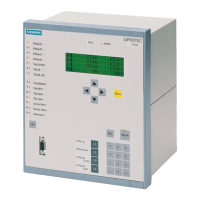Monitoring of the Circuit Breaker Auxiliary Contacts
Evaluation of the circuit breaker's auxiliary contacts depends on the type of contacts, and how they are
connected to the binary inputs:
•
the auxiliary contacts for circuit breaker "open" (4602
>52-b
) and "closed" (4601
>52-a
) are configured,
•
only the auxiliary contact for circuit breaker "open" is configured (4602
>52-b
),
•
only the auxiliary contact for circuit breaker "closed" is configured (4601
>52-a
),
•
none of the two auxiliary contacts is configured.
Feedback information of the auxiliary status of the circuit breaker is evaluated, depending on the allocation of
binary inputs and auxiliary contacts. After a trip command has been issued it is the aim to detect — if possible
— by means of the feedback of the circuit breaker's auxiliary contacts whether the breaker is open or in inter-
mediate position. If valid, this information can be used for a proper initiation of the breaker failure protection
function.
The logic diagram illustrates the monitoring of the circuit breaker's auxiliary contacts.
[7sj80-erzeug-svs-int-sign, 1, en_US]
Figure 2-110 Logic diagram for breaker failure protection, monitoring of the circuit-breaker auxiliary
contacts
Logic
The entire breaker failure protection function may be turned on or off, or it can be blocked dynamically via
binary inputs. If breaker failure protection is initiated, an alarm message is generated. With the initiation, two
setable delay times are started. One delay time can be used to repeat the trip command to the local circuit
breaker. The other is used to trip the higher-level circuit breaker. If criteria for a pickup are still met once the
time delays have elapsed, the trip signals are issued successively
If the criteria that led to the pickup are no longer met, after the time delays have elapsed, then the pickup will
drop out and no trip signal is issued by the breaker failure protection function.
To protect against nuisance tripping due to excessive contact bounce, a stabilization of the binary inputs for
external trip signals takes place. This external signal must be present during the entire period of the delay
times, otherwise the timer is reset and no tripping signal is issued.
The following figure shows the logic diagram for the breaker failure protection function.
Functions
2.18 Breaker Failure Protection 50BF
SIPROTEC 4, 7SJ62/64, Manual 265
C53000-G1140-C207-8, Edition 08.2016

